It was only a few tens of thousands of years ago that huge marsupials roamed Australia’s savannas – similar to the large herds that roamed the Serengeti. If one of these animals died, the users were not far away. Such scavengers included vultures, according to Flinders University’s Ellen Mather and her team, as they write in »Zootaxa«.
The working group had reexamined fossil bird bones found 100 years ago and compared them with other material that had been unearthed in recent years. At the time, paleontologists identified it as the remains of an eagle, but Mather and co, after comparing the bones to those of various raptors, came to a different conclusion. The lower foot bone, for example, was too weak to actively capture prey. “It was immediately clear that this bird was not adapted to hunt and was therefore neither a goshawk nor an eagle,” says Mather.
A phylogenetic analysis also assigned the species to vultures and not true eagles. Accordingly, the team changed the naming of the species from Taphaetus lizard to Cryptogyps lizardto the kinship with the lineage of the Old World vulture genus Gyps to clarify.
“The discovery solves the mystery of what happened to so many carcasses of megafauna before vultures supposedly existed on the continent. Now we know they were here. They were hidden in plain sight,” says Trevor Worthy of Flinders University, who was involved in the study. The first bone of Cryptogyps lizard, a fragment of a wing bone, was found in 1901 near Kalamurina Homestead on the Warburton River in South Australia. Its discoverer believed it to be an extinct relative of the wedge-tailed eagle, which still lives in Australia today and does not disdain carrion.
–

